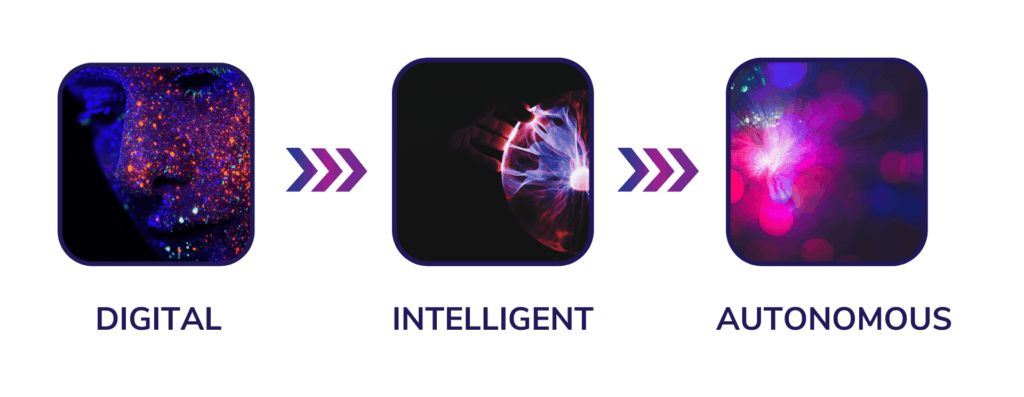Remember those times when we used to stroll down the block and find local stores such as the mom-and-pop diners and get the chance to relish the coziness and sense of family environment there. Even mom-and-pop stores and diners had to step up their digitalization game with the pandemic erupting. Being listed on a last-mile-delivery service platform and reaching a much broader customer base beyond the neighbors became a must-have for survival.
Digital commerce efficiently requires the digitalization of many customer-facing operations and sourcing and procurement. For businesses of all sizes, the digital transformation of supply chain planning became the most important initiative.
Considering this surge in digital transformation and the changing needs of 2021, here are some insights and tips for embarking on Supply Chain Digital Transformation projects.
Digital Transformation Journey
The goal of digital transformation in supply chain planning functions is to create a Digital Twin that is the digital replica of the supply chain. It includes all of its elements: customers, sales channels, products, warehouses, logistics network, and the interactions between them.

Digital transformation for supply chain planning consisting of three levels: Digital, Intelligent and Autonomous. This is a framework for defining the scope and phasing of the initiatives. Now let us dig into the dimensions of this digitalization journey.
1. Going Digital: Creation of the digital foundation
Supply chain planning involves interaction with different types of information based on internal and external data sources. These data sources are often spread across multiple platforms and come in various formats. Planners spend their precious time collecting and synthesizing the data to drive insights.
Here are the steps to take for going digital:
The First Step: Bring all the data together and ensure analytics and planning can happen on the same platform.
As a priority, bringing as much of the data for making the right daily decisions has a significant impact on agility and speed. This includes internal and external data sources. You can start with daily/operational decisions and work your way to tactical and strategic decisions to evaluate opportunities for integrating the data sources into your planning and analytics platform.
Keep in mind that you don’t have to wait to build a data-lake to consolidate all of the data. Planning platforms can pull data from multiple internal and external data sources. You need to accept that data will NEVER be 100% clean and consistent or maintained promptly. Ensure that, somewhere along the way, data diagnostic tools will be used to check for missing and inconsistent data automatically.
Second Step: Ensure data quality and consistency as they are the essential factors in driving automation. If your planning platform has inaccurate data and you don’t have visibility on the data’s quality, you will need to keep the outputs. Instead, the goal should be to focus on maintaining the inputs to ensure you are getting realistic insights and recommendations.
Most typical data related challenges to be addressed when going digital:
- Inaccurate and incomplete product and location hierarchy and attribute data
- Maintaining all past and future promotional events in a database
- Accurate and timely reconciliation of purchase orders with receipts
- Having accurate stock-out data
- Having up-to-date supplier lead times
- Maintaining business and commercial rules in a systematic manner
- Maintaining outlier events that have influenced demand patterns or supply availability
One goal of these steps should be to provide end-to-end visibility across the organization through interactive dashboards and a single version of the truth. In doing this, you will uncover many data consistency and quality issues and lay the foundation for bringing in the intelligence layer.
Third step: Explore how you can expand supply chain visibility to your suppliers and logistics providers, and retail channel partners so you can start getting signals of unusual events that will impact your plans.
Fourth Step: Benchmark KPIs to understand limitations and discover opportunities. Creating dashboards in this step will also enable you to benchmark your KPIs before proceeding with the following steps on your journey and help you measure the before & after results.
Some helpful KPIs to benchmark at the beginning of your journey are:
- Product Availability – being able to view the availability of different product segments to see products that matter most for your business
- Service Levels by location/channel/customer and product hierarchy – being able to view these with the contribution to sales
- On-time-in-full performance of suppliers and scorecards where multiple KPIs are combined
- On-time-in-full performance of distribution centers
- Customer Satisfaction scores side by side with the service level and availability metrics
In the process of benchmarking these KPIs, you will discover and have opportunities to assess the capabilities and the limitations of the existing systems and the processes, identify the data issues, improve the quality of your data and be in a better position to drive intelligent insights.
Fifth step: Internal & external digital collaboration is also a part of going digital. These capabilities can bring efficiencies to decision-making across the supply chain. The cross-functional and cross-enterprise collaboration will become easy when all stakeholders are looking at the same version of the truth.
2. Creating Intelligence

Once you have the core data and assess the quality and reliability, you can start adding the intelligence layer. Intelligence can come in many shapes and forms:
- Diagnostic Alerts: will help you focus on the areas which need immediate attention or improvement, such as products or locations where you are experiencing availability problems.
- Predictive alerts: will help you prevent potential issues such as stock-out risks
- Analytical insights: will help you gain several insights such as the impact of price changes, the influence of weather, and other demand-drivers.
AI/ML technology will help with many aspects of your supply chain planning both on the demand and supply side.
Examples of building intelligence in your processes:
- Automating product segmentation based on multiple dimensions including revenue, demand variability, supplier lead-times to manage different service level targets
- Understanding the impact of the market price index on your demand
- Analyzing the root cause of stock outs
- Modeling the impact of weather events
- Automatic identifying and removing outlier events from the historical data
- Modeling impact of promotions and campaigns
- Estimating revenue impact of lost sales when stock-outs occur
- Uncovering halo and cannibalization effects across your product portfolio
- Understanding the impact of external trends on your sales performance
- Attribute-based forecasting when introducing new products
- Having dynamic safety-stock calculations
During the COVID-19 pandemic, one important capability was enabling scenario-planning capabilities. Quick scenario planning has become one of the most sought-after capabilities in supply chain planning. Predictive analytics feeding scenario planning definitely gives a competitive edge when reacting to changes in the business environment. Once you have your process(es) modeled with real-life scenarios, parameters, and constraints, you have a digital twin that will save a lot of time and support fast-decision-making.
Scenario planning can happen at different levels in the organization. Your planning platform should support integrating operational, tactical, and strategic decisions to make daily operational decisions in line with the tactical and strategic targets and parameters.
Having an intelligence layer providing actionable insights will enable faster decision-making and agility during uncertain times.
3. Going Autonomous
Just like autonomous cars are now a reality, so is autonomous supply chain planning for most daily operational decisions. Replenishing stores to meet availability targets or adjusting prices to keep a certain competitive position in the market are just some examples. While the goal can be to automate many of the planning decisions, keep in mind that there will always be tactical and strategic decisions that will not be automated but can still benefit from digital transformation.

Many decisions made on a daily/weekly basis, such as inventory target setting, store replenishment, procurement planning, markdown optimization, dynamic pricing, order fulfillment, transportation planning, are candidates for autonomous planning. Of course, autonomous planning does not happen overnight, and it is not just about having the technology. Autonomous planning can happen in steps as the organization advances its digital maturity. When embarking on an autonomous planning project, it is essential to clearly define what you plan to achieve with supply chain planning automation.
Consider the following as different levels of complexity you can achieve:
- Covering existing orders and prevent supply shortages
- Having a volume-based operational plan using sales forecast and constrained supply capability
- Optimizing supply and demand matching across the end-to-end supply chain
- Making demand-driven, profitable supply response to anticipated demand across the extended supply chain (e.g., key customers and/or suppliers)
- Strategically aligning value network plan supporting growth, identifying new demand channels, and speed to market.
Regardless of the complexity of the autonomous planning capabilities, there will always be a need to monitor the system and quickly identify exceptions that need to be addressed and manage overrides when needed. Therefore autonomous planning should not be treated as just a black box running your operations. Data diagnostics to ensure the inputs are accurate, KPI monitoring and alerts for intervention and root-cause analysis are essential components to guide the planners.
Keep in mind that while big data and advanced technology can drive autonomous planning, there are still organizational change management aspects that need to be planned and executed. Measuring user adoption is a good idea to quickly diagnose and address the various issues that get in the way of fully autonomous planning.
If you would like to learn more about becoming your partner in this journey, go ahead and book a meeting with me!
Also, follow us on LinkedIn and YouTube for more information and read our customer case studies on the digital transformation of supply chain planning.









